Updated on April 12, 2014
Nikolay Nikolayevic Polikarpov, the future "king of fighters", was
born on 10th June 1982 in a village in the Oryol province.
He started to work in the detached offices of St.Petersburg of the
aircraft factory Duks (from the latin word Dux, chief) of
Khodynka, near Moscow, even before graduating at the Polytechnic Institute
in 1916.
Then he worked under Igor Sikorsky, that escaped in the US after the
Russian Revolution.
By September 1918, he was made chief of the technical department of
Duks of Khodynka; he adapted the De Havilland D.H.4 to Soviet necessities,
developing from it the R-1 reconaissance aircraft and organizing its production;
2,800 of such aircraft were built for the Soviet Air Force.
In January 1923, the young Nikolay Nikolayevic Polikarpov was
appointed as chief of the new aircraft design office of GAZ-1 (Gosoodarstvennyy
Aviatsionnyy Zavod, state aircraft factory, already
Duks)
in Khodynka. |
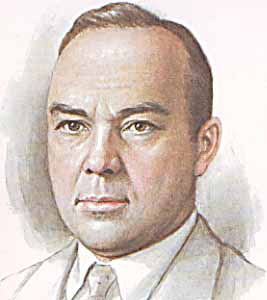 |
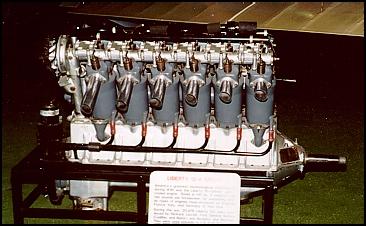 |
His charge was to create a new fighter powered by a 400 hp Liberty
engine.
This was an U.S. produced water-cooled 12 cylinders vee engine, equipping
US-built DH-4s during the WW1, and surpassed foreign contemporary engines.
Giving the bad relations between Soviet Union and USA due to the Communist
revolution, it would have been difficult to obtain the production licence,
but Soviets copied the engine all the same under the name M-5, replacing
US measurements with metric ones to sidestep licence regulations. |
In February, Polikarpov and his work were transferred to the centralized
office Glavkoavia;as a consequence, the original project never materialized,
due to lack of enthusiasm of GAZ-1 for a project drawn outside.
In April 1923, Polikarpov was charged to project a monoplane fighter
with Liberty engine. Some time before he had occasion to examinate a German-built
Junkers all-metal monoplane.
To avoid repetition of the previous opposition, he asked to I.M.Kostkin,
director of the technical department of GAZ-1, and A.A.Popov, production
manager, to be joint leaders of the project.
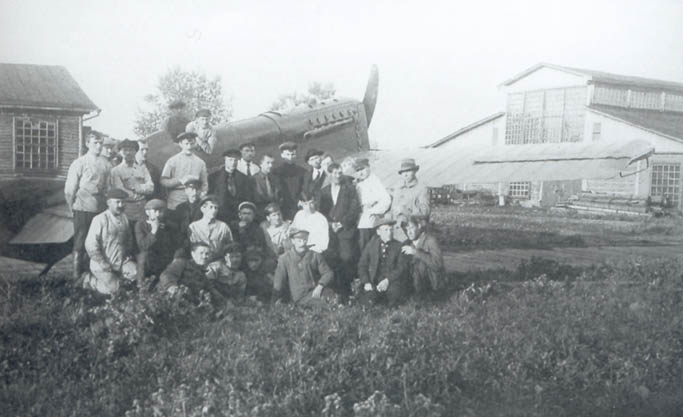 Image from Polikarpov I-16 fighter-its forerunners and progeny
of Yefim Gordon and Keith Dexter, Midland Publishing
Image from Polikarpov I-16 fighter-its forerunners and progeny
of Yefim Gordon and Keith Dexter, Midland Publishing |
IL-400 (Istrebitel Liberty 400 hp) had to be built of wood and fabric, with
propeller and radiator identical to those of R-1 (an adaptation of the British
aircraft De Havilland D.H.9A).
The fuselage was covered by plywood, had a rectangular section with rounded
top.
The cantilever wings had two spars, they were tapered in chord and their
profile was strongly curved. The ailerons and all the tail surfaces
were covered by fabric and unbalaced.
The prototype was built within August 1923, and tested in Khodynka
airport near Moscow.
|
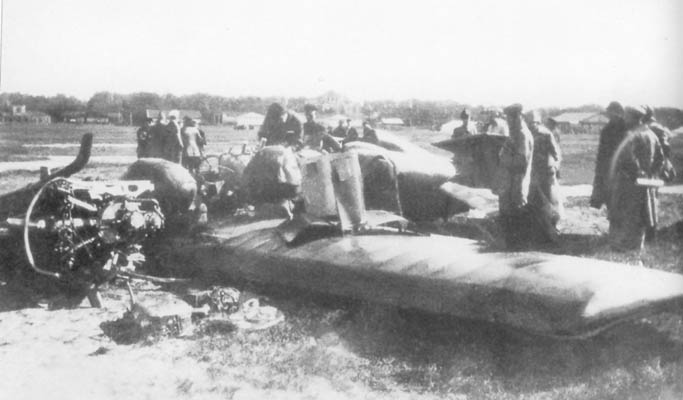
Image from Polikarpov I-16 fighter-its forerunners and
progeny of Yefim Gordon and Keith Dexter, Midland Publishing
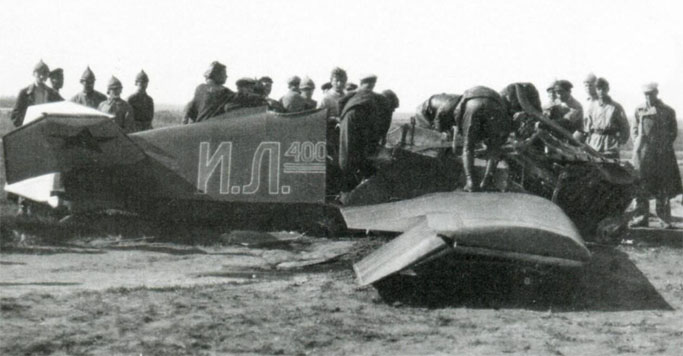
|
The aircraft appears to be painted green overall, possibly with silver
undersurfaces, natural metal nose and white rudder without fin.
The name I.L.400 was written in red and white on the sides, while red
stars were painted on the rudder and both below and (probably) above the
stabilizers..
Some test runs showed that the aircraft was too heavy on its tail,
that refused to lift from the ground.
A second attempt was made after having moved back the landing gear, but
the aircraft was longitudinally unstable, and started climbing at high
angle; the pilot was unable to level it, and cut the engine to land.
The aircraft stalled immediately and crashed from 20 m, injurying the
pilot K.K. Artseulov.
After tests in the wind tunnel of TsAGI (Central Institute for Aerodynamics
and Hydrodynamics), it was decided to built another prototype with a CG
moved forward, and widely revised both structurally and aerodinamically.
|
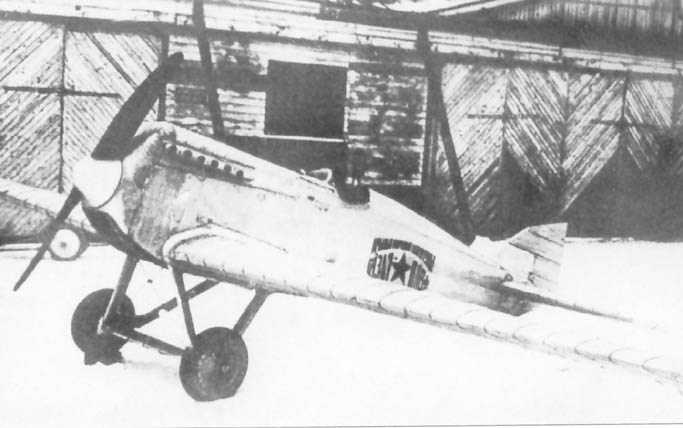 Image from Polikarpov I-16 fighter-its forerunners
and progeny of Yefim Gordon and Keith Dexter, Midland Publishing
Image from Polikarpov I-16 fighter-its forerunners
and progeny of Yefim Gordon and Keith Dexter, Midland Publishing
|
IL-400b (bis), also referred as IL-2, was approved by the authorities
on March 1923.
The fuselage had a plywood-covered wooden structure, with some parts
in alluminium alloy and a more squared cross section than the ill-fated
first prototype.
The cockpit was wider and moved forward to improve visibility.
The radiator was internal to the cowling.
On this image, we see the aircrafts without some fairings on the engine
cowling and under it, that are visible in some following images. |
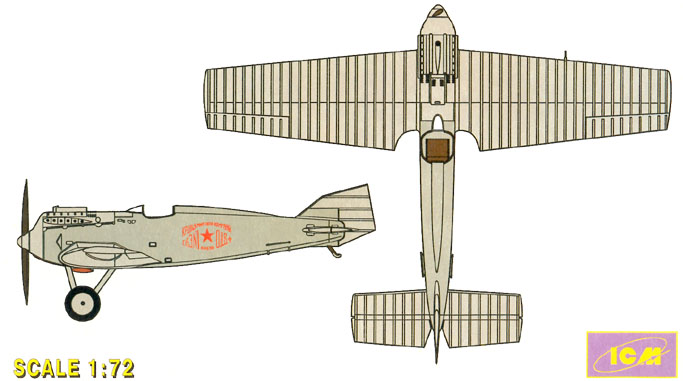 |
The wings were of shorter span, with thinner section and corrugated
allumimium alloy skinning with dural ribs.
It had some cut-outs at the wingroot to improve visibility downward.
The tail surfaces were skinned by corrugated alluminium alloy too.
The rudder only was balanced, while the ailerons and elevators were
not.
Two 7,62 mm syncronized machine guns were installed on the nose.
Image (not to 1/72 scale!) from ICM plastic kit |
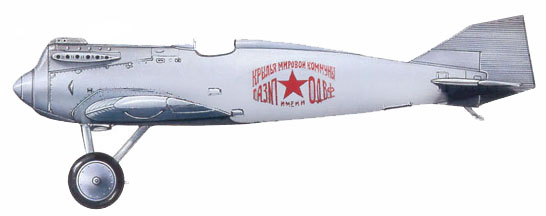
|
On its sides, it had painted a banner with the slogan Krylya mirovoy
kommoony GAZ- No.1 imeni ODVF , that means wings of the world Commune,
GAZ no.1 named after the ODVF (ODVF was a civilan organization to support
the Soviet AF)
drawing modified from Polikarpov I-16 fighter-its forerunners
and progeny of Yefim Gordon and Keith Dexter, Midland Publishing |
 Image from Polikarpov I-16 fighter-its forerunners
and progeny of Yefim Gordon and Keith Dexter, Midland Publishing
Image from Polikarpov I-16 fighter-its forerunners
and progeny of Yefim Gordon and Keith Dexter, Midland Publishing
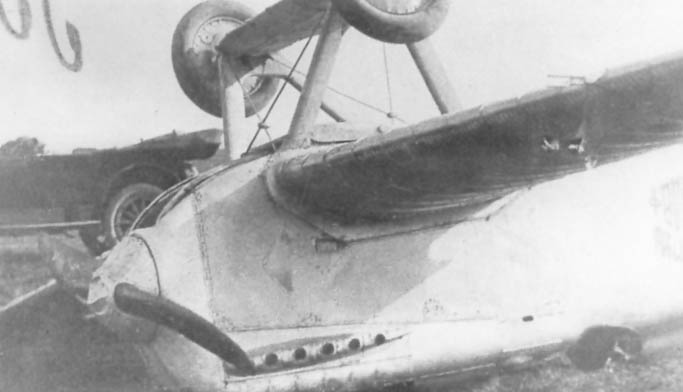 |
.
IL-2 flew on July 1924, the pilot being again K.K. Artseulov,
who had recovered from the previous injuries.
Later, the aircraft was flown by A.I. Zhukov and A.N. Ekatov.
The performances were well superior to the specifications of VVS, and
superior to the most of foreign fighters.
It flew at 263 km/h at ground level and 275 km/h at altitude, and responded
well to the commands, but the flight controls were heavy, so it was required
a redesign of the tail control surfaces.
Here we see the aircrat damaged by a bad landing.
The difference in shade between bare alluminium surfaces and alluminium
painted wooden surfaces is visible here.
|
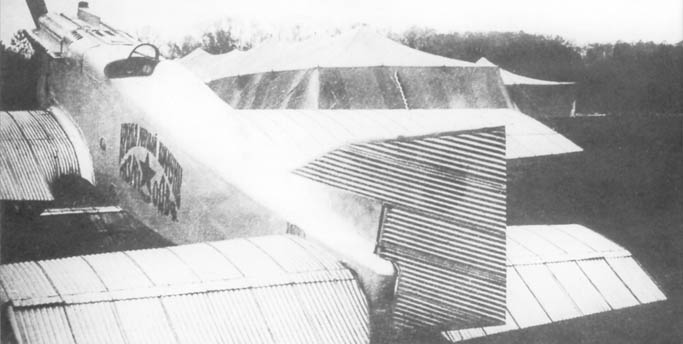 Image from Polikarpov I-16 fighter-its forerunners
and progeny of Yefim Gordon and Keith Dexter, Midland Publishing
Image from Polikarpov I-16 fighter-its forerunners
and progeny of Yefim Gordon and Keith Dexter, Midland Publishing
|
After the factory trials, the State tests started on 17 October 1924.
In February 1925, afer replacing the engine, the aircraft was shown
to the Commander in Chief of the Soviet AF, P.I.Baranov.
The protruding fairing over the engine cowling was restyled and appears
rectangular in profile instead than trapezoidal.
The exhaust stacks seems modified too, being more protruding and possibly
similar to those of the first prototype.
Note the dark instrument panel with white quadrants and black pointers. |
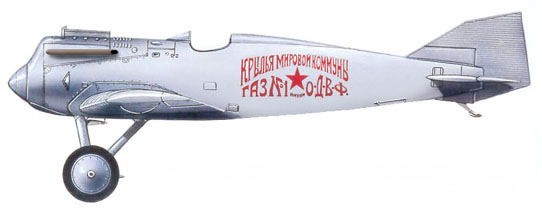
|
After repairs, the banner on the sides was repainted in a slightly
modified form.
drawing modified from Polikarpov I-16 fighter-its forerunners
and progeny of Yefim Gordon and Keith Dexter, Midland Publishing |
After successful tests it was ordered the production of a batch of 8
pre-series aircrafts at GAZ-1. It was decided to revert to the wooden structure
skinned with plywood on wings and tail, due to shortage of alluminium
alloys.
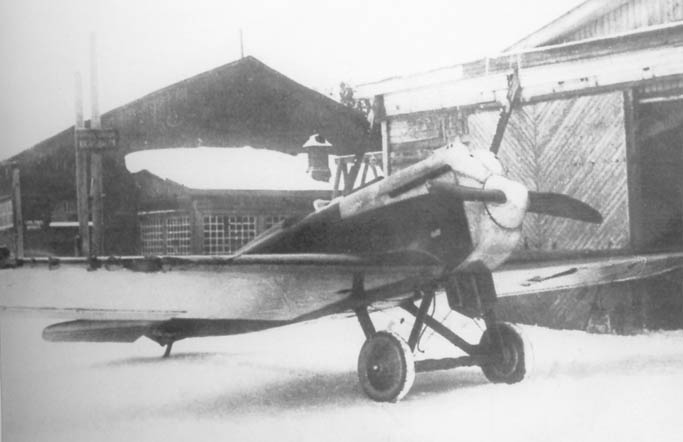 Image from Polikarpov I-16 fighter-its forerunners
and progeny of Yefim Gordon and Keith Dexter, Midland Publishing
Image from Polikarpov I-16 fighter-its forerunners
and progeny of Yefim Gordon and Keith Dexter, Midland Publishing
|
A third prototype, known as IL-3, was built and flown in early 1926.
It went to state trials on March and was flown by A.I. Sharapov, but
it was destroyed because of an unrecovered spin. Sharapov couldn't bail
out, but survived the crash.
This photo is believed to show the third prototype.
We see that the nose shape was similar to the second prototype, but
the wings and tail were smooth, and had a more rounded shape.
The aerodynamic cooling surfaces on the nose were replaced by a traditional
honeycomb cooler.
|
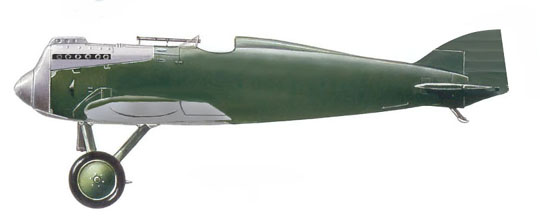
|
The aircraft looks to be painted olive green, with bare alluminium
nose and possibly silver painted undersurfaces. It seems to have a telescopic
sight in front of the windscreen (probably offset on the right to avoid
interference with the part protruding on the engine cowling).
drawing modified from Polikarpov I-16 fighter-its forerunners
and progeny of Yefim Gordon and Keith Dexter, Midland Publishing |
In addition to 8 pre-production aircrafts, 25 series aircrafts were
ordered for production.
In the factory, they were known as IL-3, but the type had the official
designation I-1 (Istrebitel 1) by State authorities.
Most of them had to be fitted with the M-5 engine, a Soviet copy of
Liberty, and were referred as I-1-M5s.
The serials of pre-series and series I-1s were from 2888 to 2921.
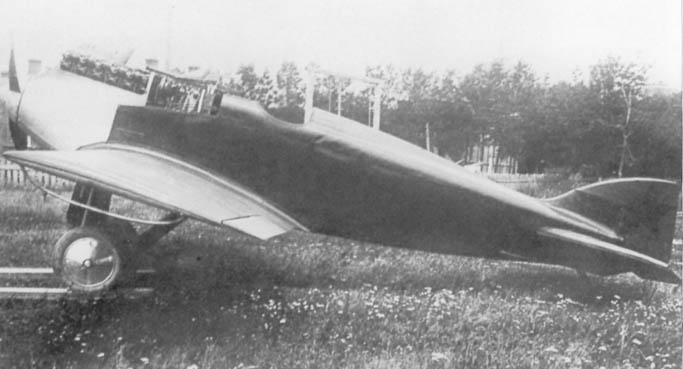 Images from Polikarpov I-16 fighter-its forerunners
and progeny of Yefim Gordon and Keith Dexter, Midland Publishing
Images from Polikarpov I-16 fighter-its forerunners
and progeny of Yefim Gordon and Keith Dexter, Midland Publishing
 |
These photos are believed to show a series aircraft close to completion.
We see:
-
longer and more pointed nose and spinner, with more rounded section;
-
traditional honeycomb water cooler;
-
exhausts without fairing, freely discharging through a slot on the cowling
sides;
-
smooth wings;
-
more rounded fuselage section;
-
more rounded tail and wings shape.
On these images, some of the engine cowling panels and the windshield
look absent.
It looks as if there was a machine gun mounted above the nose profile,
but this could have not been its definitive position.
The series and pre-series aircrafts were not all identical, some modifies
are said to be introduced from aircraft to aircraft.
|
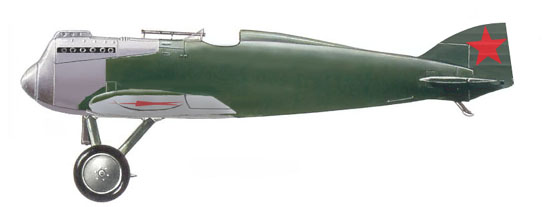
|
The aircraft seems to be painted with:
-
green uppersurfaces;
-
silver undersurfaces;
-
bare metal engine cowling and spinner;
-
polished metal wheel disks;
-
red stars on the wings and on the rudder.
drawing modified from Polikarpov I-16 fighter-its forerunners
and progeny of Yefim Gordon and Keith Dexter, Midland Publishing |
On November 1925, a derivative called Il-4, I-6 or IL-400v (the third
letter of cyrillic alphabet) was proposed. It should have been a polivalent
fighter , built both as single-seater (IL-400v), two seater (2IL-400v)
and reconaissance version (RL-400v).
It should have featured greater and stronger wings containing the fuel
tanks, moved-aft cockpit, more streamlined shape and new tail unit.
The state authority didn't consider realistic this polivalence, and
authorized only the construction of the single-seat fighter, with few convinction;
the work was stopped in early 1926 because of the problems that the series
I-1 were having.
The production of the I-1 was upset by an accident occurred to another
aircraft, the 2I-N1 biplane escort fighter of Polikarpov, on March 1926.
This prototype crashed, killing the crew of two, because the skin covering
was torn away, causing the wings collapse. This was due to bad gluing of
the wing skin to the structure. Besides, the structure seemed not rigid
enough.
A similar construction system was utilized to manufacture the wings
of the I-1s, and this creates worries and delays. In fact, wooden wings
were revealed too weak by loading tests.
The series I-1s suffered from poor craftmanship, were too heavy and
dangerously unstable. Wings required to be reinforced, and this added further
weight. The centre of gravity resulted too aft again.
A series aircraft was tested at NII VVS (the Scientific Institute of
the Air Force) by pilot M.M.Gromov, and the test confirmed the difficulty
to recover from spinning. The phenomenon was new and nearly unknown, because
biplanes were not subject to spinning.
On June 23, 1927 Gromov bailed out with parachute (for the first time
in SU) because he could not recover from a spin.
A second I-1(with Liberty engine, serial no. 2895) was delivered to
NII VVS on 17 June.
The original idea was to make serviceable all the 31 aircrafts built
by October 1926, but, due to these difficulties, the first 12 arrived to
units only during the sping of 1927.
Their flight characteristics were not appreciated by pilots, accustomed
to biplanes, and the aircrafts were refused by the VVS.
Only 18 of 31 aircrafts were completed, and only one (serial no.2895)
was officially accepted by te VVS.
The time was not mature for monoplane technology. The aerodynamic structures
necessary to reach higher speeds were heavier than those of biplanes, and
the power of engines of 1925 didn't allow to use well the advantages of
the newer formula, that were not sufficient to renounce to the easy of
flight and to the reliability of biplanes.
Sources:
Polikarpov I-16 fighter-its forerunners and progeny of Yefim Gordon and
Keith Dexter, Midland Publishing
Soviet Aircraft and Aviation 1917-1941 of Lennart Andersson, ed Putnam
http://vvs.hobbyvista.com/ModelReviews/Bittner/I1/index.php
http://vvs.hobbyvista.com/ModelGallery/poli_i1.php
http://www.ctrl-c.liu.se/misc/ram/i-1polik.html
http://eroplan.boom.ru/shavrov/chr9/fighter/fight1.htm
http://www.ratomodeling.com/finished/il400/
an excellent and very detailed building report of the ICM kit.
















